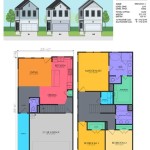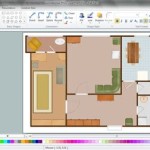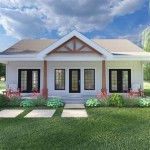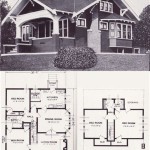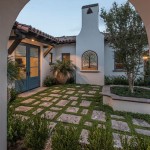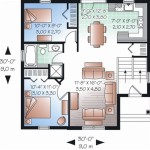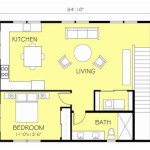Small House Plans: Modern Design for Compact Living
The increasing interest in small house plans, particularly those embracing modern design principles, reflects a significant shift in residential preferences. This trend is driven by a confluence of factors, including affordability, environmental consciousness, and a desire for simpler, more manageable lifestyles. Modern small house plans prioritize functionality, efficiency, and aesthetic appeal within a limited footprint, offering a compelling alternative to larger, more conventional homes.
Modern design, when applied to small house plans, typically emphasizes clean lines, open layouts, and an abundance of natural light. The use of sustainable materials and energy-efficient technologies is also a key characteristic. Furthermore, these designs often incorporate smart storage solutions and multi-functional spaces to maximize the available area. The result is a home that feels spacious and comfortable despite its smaller size, providing a high quality of life for its occupants.
The pursuit of smaller homes is also linked to a growing awareness of the environmental impact of larger residences. Smaller homes require less energy for heating and cooling, consume fewer resources during construction, and generate less waste. This makes them a more sustainable choice for environmentally conscious individuals and families. Moreover, the reduced financial burden associated with smaller homes allows occupants to invest more in experiences, travel, and other personal pursuits.
Maximizing Space and Functionality
One of the primary challenges in designing small houses is maximizing the use of available space. Modern small house plans address this challenge through a variety of innovative strategies. Open floor plans are a common feature, eliminating unnecessary walls and creating a more fluid and connected living area. This allows for improved natural light penetration and a greater sense of spaciousness.
Multi-functional furniture is another key element in maximizing space. For example, sofa beds can serve as both seating and sleeping areas, while expandable tables can be adjusted to accommodate varying numbers of guests. Built-in storage solutions, such as shelves and cabinets integrated into walls, are also essential for keeping clutter at bay and optimizing usable space.
Vertical space is often underutilized in traditional home designs. Modern small house plans frequently incorporate strategies to leverage vertical space, such as loft areas for sleeping or storage, and tall, narrow storage units. This allows homeowners to maximize the available square footage without significantly increasing the footprint of the house.
Another important aspect of maximizing functionality is careful consideration of the layout. The placement of rooms and the flow between them should be designed to minimize wasted space and optimize efficiency. For example, placing the kitchen adjacent to the dining area can streamline meal preparation and serving. Similarly, locating the laundry area near the bedrooms can make laundry tasks more convenient.
Embracing Natural Light and Ventilation
Natural light and ventilation are crucial for creating a comfortable and healthy living environment, especially in small spaces. Modern small house plans prioritize these elements through the strategic placement of windows and doors. Large windows, skylights, and glass doors can flood the interior with natural light, making the space feel brighter and more open.
The orientation of the house on the lot is also an important factor to consider. Positioning the house to take advantage of sunlight during the day can reduce the need for artificial lighting and heating. Overhangs and awnings can be used to provide shade during the hottest parts of the day, preventing excessive heat gain.
Proper ventilation is essential for maintaining good indoor air quality and preventing moisture buildup. Cross-ventilation, which involves placing windows and doors on opposite sides of the house, allows for natural air circulation. Operable windows and skylights can be opened to allow fresh air to enter and stale air to escape.
The selection of window treatments can also impact natural light and ventilation. Light-filtering shades or curtains can provide privacy while still allowing daylight to enter. Blinds can be adjusted to control the amount of light and airflow. In some cases, solar screens can be used to reduce heat gain and glare without blocking natural light.
Incorporating Sustainable Materials and Energy-Efficient Technologies
Sustainability is a core principle of modern design, and it is particularly important in small house plans. By using sustainable materials and energy-efficient technologies, homeowners can reduce their environmental impact and lower their operating costs. This commitment to sustainability extends beyond the construction phase and encompasses the entire lifecycle of the house.
Sustainable materials are those that are renewable, recycled, or locally sourced. Bamboo, reclaimed wood, and recycled steel are examples of sustainable building materials. These materials have a lower environmental impact than conventional materials such as concrete and virgin timber. They also often have unique aesthetic qualities that can enhance the overall design of the house.
Energy-efficient technologies can significantly reduce energy consumption and lower utility bills. High-performance windows and insulation can minimize heat loss in the winter and heat gain in the summer. Energy-efficient appliances, such as refrigerators, washing machines, and dishwashers, can further reduce energy consumption. Solar panels can be installed on the roof to generate electricity, reducing reliance on the grid.
Water conservation is another important aspect of sustainability. Low-flow toilets, showerheads, and faucets can significantly reduce water consumption. Rainwater harvesting systems can be used to collect rainwater for irrigation and other non-potable uses. Drought-tolerant landscaping can minimize the need for irrigation.
Smart home technologies can also contribute to sustainability. Smart thermostats can automatically adjust the temperature based on occupancy and weather conditions, reducing energy waste. Smart lighting systems can automatically dim or turn off lights when they are not needed. These technologies can help homeowners monitor and optimize their energy and water consumption.
The design of small homes also allows for a more efficient use of materials, reducing waste during construction. Prefabricated or modular construction methods can further minimize waste and speed up the building process. These methods involve constructing components of the house in a factory setting and then assembling them on site.
In conclusion, modern small house plans offer a compelling solution for those seeking affordable, sustainable, and stylish housing options. By prioritizing functionality, embracing natural light and ventilation, and incorporating sustainable materials and energy-efficient technologies, these designs provide a high quality of life within a compact footprint. The continued growth in popularity of small house plans reflects a broader shift towards simpler, more sustainable lifestyles.

Pin On One Bedroom House Plans

Best Ing Small House Plans Mark Stewart Modern Home Design

Modern Style On A Budget 10 Tiny Cool House Plans Houseplans Blog Com

18 Small House Designs With Floor Plans And Decors

Tiny Modern House Plans Small And Floor

Plan 76474 Small Modern Floor Vacation Home

Tiny Modern House Plans Small And Floor

Folkstone 5178 1 Bedroom And 5 Baths The House Designers

Affordable Home Ch61 Small Modern House Plans Beach

Small Modern House Plans Home Floor Designs The Designers

